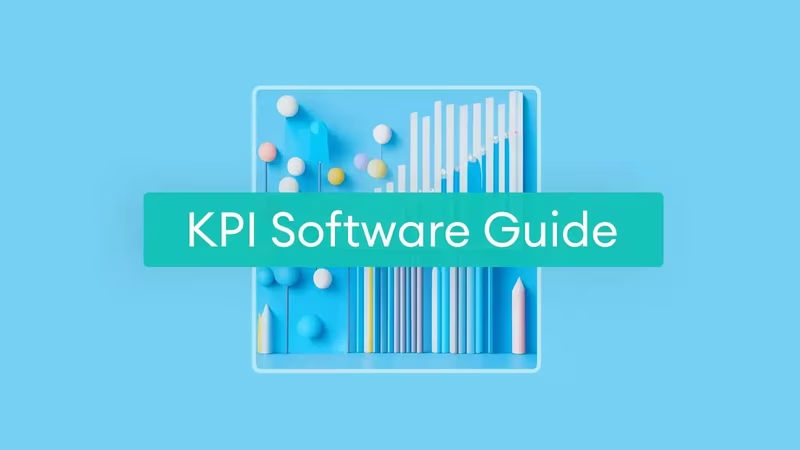The 14 best KPI software platforms and how to choose a KPI tool in 2025
Do you ever feel like you're just winging it in business, hoping for the best but not really sure if you're on the right track?
That's when you’re told by every business strategist and internet guru that Key Performance Indicators (KPIs) are your savior. But let's be honest, you’ve been trying to tame those KPIs with endless spreadsheets, and you’ve realized they are a fast track to a major headache.
The good news is that picking the right KPI software can seriously remove a lot of the pain.
So, choosing a dependable KPI software platform is essential for hitting those targets, reducing the pain and hitting your targets.
If you're ready to get a clear view of what’s what, you're in the right place! We’re about to dive into the top 14 KPI software platforms businesses like yours should be looking at in 2025, and we'll walk you through how to pick the absolute best one for your needs.
- Best 14 KPI Software Platforms
- At a Glance: KPI Software Platforms Compared
- What are the Key Features I Should Consider?
- How Do I Choose the Right Platform for Me?
- Why do companies use KPI Software
- Frequently Asked Questions
- Conclusion
Best 14 KPI Software Platforms
Ranked in no particular order, here are 14 of the best KPI Software Tools available.
#1 SimpleKPI: A Leader in KPI Software for 2025
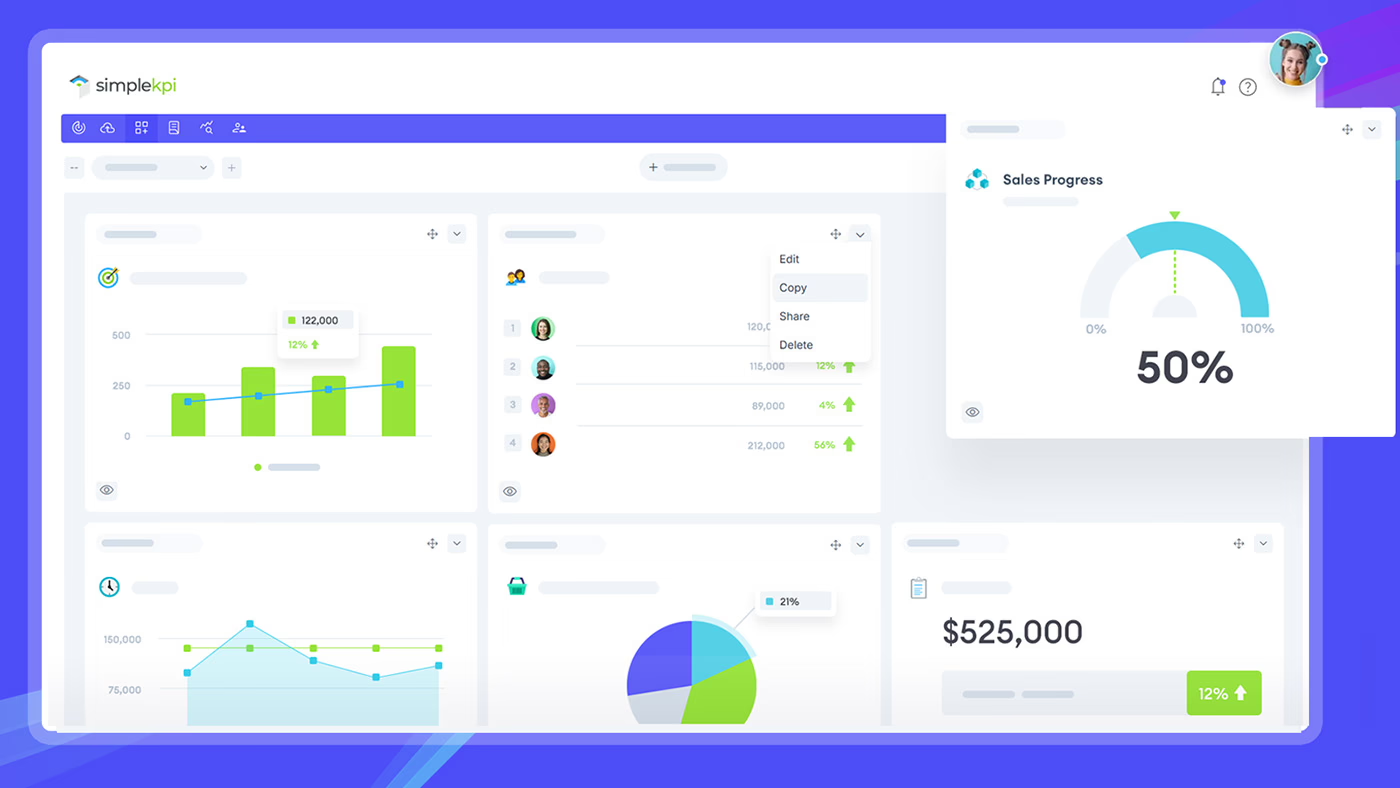
So, anyone on the hunt for KPI software that actually gets the job done should get to know SimpleKPI. It's not just another name in the software game; it's the preferred tool for over 50,000 users globally who were fed up with complicated ways to track performance . Why are so many users happy? Because its incredibly smart (yet surprisingly easy-to-use) tools are laser-focused on one thing: helping businesses shine. Think clearer insights, much healthier profit margins, and operations that run smoother than a well-oiled machine .
If you need all those essential KPI features without the usual fuss, SimpleKPI has packed its platform with everything a business actually needs:
- Killer KPI Dashboards: These bring data to life quickly with interactive charts and graphs .
- Crystal-Clear Reports: Users can create and share meaningful insights with their teams and colleagues effortlessly .
- Deep-Dive Analytics: This helps businesses really understand the ups and downs to make sense of their data .
- Seamless Integrations: It connects with tools you're likely already using, like Zapier, Google Sheets, and Excel .
Forget about struggling with data – users can just connect their sources and watch as they whip up beautiful, insightful dashboards and reports that show exactly what’s happening in their business .
But here’s where SimpleKPI really hits the mark: it finds that perfect balance between being super powerful and incredibly easy to use . Is it packed with features? Absolutely. A nightmare to set up or figure out? Not at all! Businesses can get up and running quickly, customize KPIs to perfectly match their specific goals, and finally feel in complete control of how they measure success . It’s KPI tracking designed for real people, not just data whizzes.
The bottom line? For any business serious about improving its performance monitoring without the drama, SimpleKPI's stellar reputation and proven track record make it a smart pick . It's all about making life easier and businesses stronger .
And the good news keeps coming! SimpleKPI is always evolving. Just this January 2025, it rolled out some seriously impressive updates:
- Fresh Design: SimpleKPI got a fresh, modern makeover. Picture a cleaner design and navigation that just works . Getting around crucial areas like Reports and Analytics is now even more intuitive .
- AI That Does the Heavy Lifting (for KPIs!): Tired of the guesswork in choosing KPIs? Users can just describe what they need to the new AI KPI Generator, and like magic, it suggests tailored KPIs, ready to go . The platform has also streamlined how users create and manage KPIs, making the whole process much faster .
- Speedier & Smoother: Users can expect an even zippier experience. Performance has been boosted across the platform with faster rendering and smoother transitions, so everything loads quickly and feels incredibly responsive .
- Help is Always Here: A new Help Center Bar has also been launched. Whether someone needs a quick answer tailored to what they're doing, a tutorial video, or a live chat, support is just a click away .
SimpleKPI's features include:
- KPI Dashboard
- KPI Reports
- Integrations / Zapier
- Analytics
- Custom Built KPIs
- Manual Entry / Excel Spreadsheet / Google Sheets
- User Management/roles and Hierarchies
- Sharing / Embedding
Pricing Plan
$49 per month up to 5 users, Unlimited Dashboards and Reports $129.99 – Unlimited Users, Dashboards, and Reports – No hidden fees
Downsides
Lacks advanced data modeling options seen in some competitors, which may limit customization for complex analytics needs.
#2 Tableau
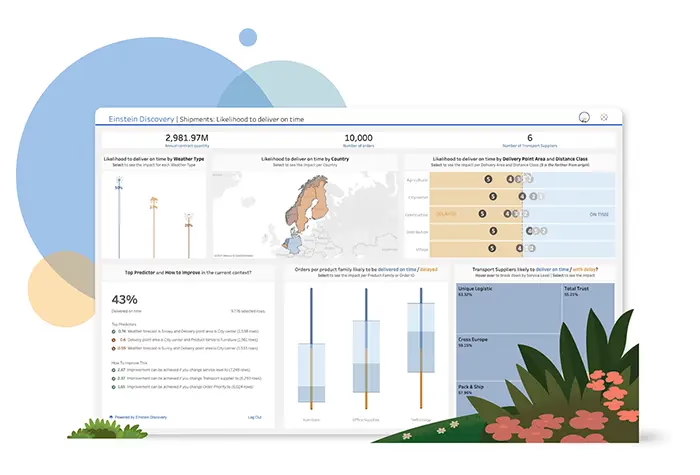
Tableau is an established and popular data visualization tool that has revolutionized the data analysis and business intelligence domains. Its versatile and user-friendly platform enables data analysts to create interactive and insightful visualizations that enable decision-makers to make informed decisions based on data-driven insights.
One of Tableau's key features is its ability to handle large volumes of data with unprecedented speed and efficiency. It can work with different data types, including text, numbers, and geographic information, and seamlessly integrate them to analyze the data comprehensively. Tableau also supports data blending, which allows analysts to combine data from multiple sources and create custom relationships between them.
Tableau's features include:
- Dashboards
- Reports
- Integrations
- Team Collaboration
- AI Data Explanations
Downsides
High learning curve for beginners; also comes with a relatively higher cost per user, which can impact smaller budgets.
Pricing Plan
$70 - $15 per user per month, depending on the plan.
#3 Yellowfin
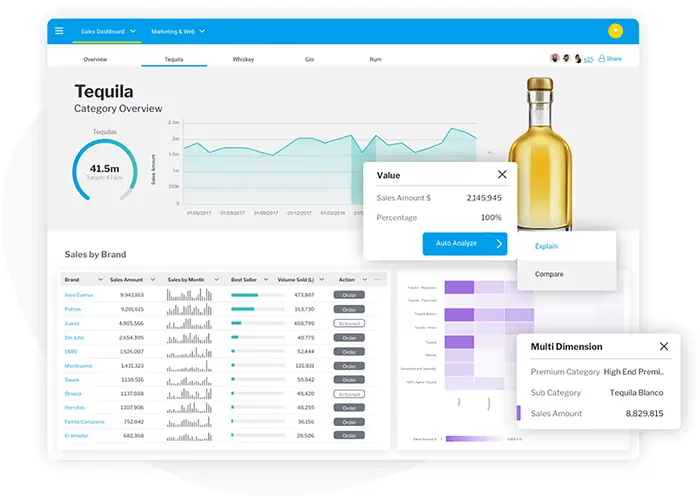
Yellowfin is a top-tier analytics and business intelligence (ABI) software vendor that offers a comprehensive suite of world-class products powered by advanced automation capabilities. It boasts a vast user base of over 3 million end-users across 75 countries and more than 29,000 organizations that rely on its platform daily. The company has garnered significant recognition from the world's leading analyst firms for its innovative approach to BI.
What sets Yellowfin apart from other analytics providers is its unwavering commitment to supporting the builders, designers, developers, data scientists, and DevOps teams who endeavor to assemble and embed data solutions into business applications and workflows. This state-of-the-art KPI software platform delivers multi-experience KPI analytics that empowers decision-makers to see, understand, and do more with their data effortlessly.
Yellowfin features include:
- Data Science Integration
- Meta-Data Modelling
- Reporting
- Data Visualization
- Dashboards
- Signals
- Assisted Discovery
- Automated KPI monitoring
Downsides
Limited integrations with third-party tools and slightly complex setup, making it more suitable for data-savvy teams.
Pricing Plan
Starting from $50 per user per month.
#4 Klipfolio
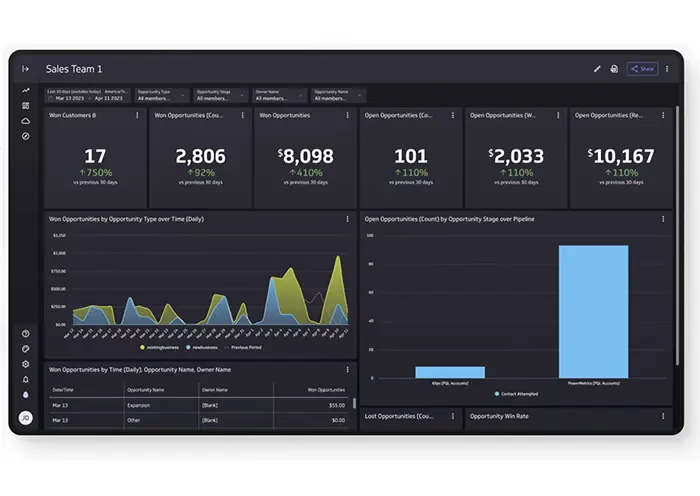
Klipfolio is an exceptional online dashboard platform that empowers users to create real-time dashboards effortlessly. Klipfolio's intuitive interface and robust features enable users to monitor critical metrics and KPIs in a fraction of the time other platforms require. The platform has captured a significant market share owing to its exceptional ease of use, cost-effectiveness, and flexibility.
Moreover, the platform offers seamless integration with various marketing, sales, accounting, and IT applications, making it the go-to dashboard platform for multiple industries.
Additionally, Klipfolio's wide range of dashboard templates, widgets, and data sources enables users to personalize their KPI dashboards and gain greater control over their data visualization. By leveraging Klipfolio's robust analytics capabilities, organizations of all sizes can make data-driven decisions, automate critical processes, and stay ahead of the competition.
Klipfolio features include:
- KPI Dashboards
- Reporting
- Integrations
- Goals and Targets
- Collaboration and sharing
Downsides
Can become expensive as users increase, and some users report issues with real-time data refresh rates.
Pricing Plan
$99 to $799 a month, from 4 users.
#5 Gooddata
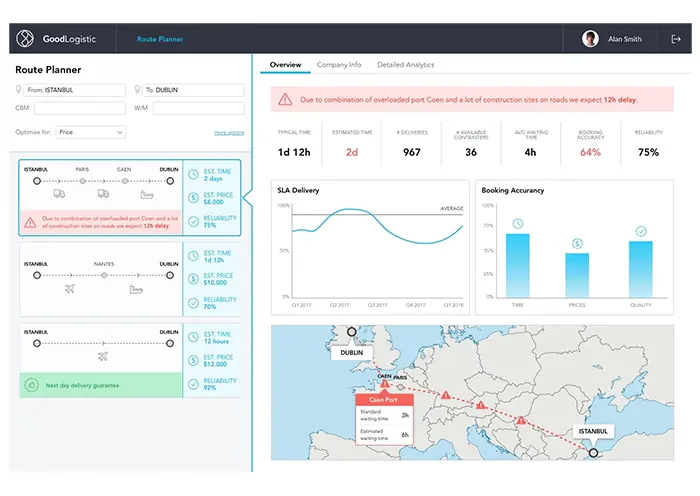
GoodData is a state-of-the-art business intelligence (BI) KPI software platform that empowers businesses to centralize their data management and analysis. With its cutting-edge technology, GoodData enables users to seamlessly track and analyze performance metrics and KPIs across multiple data sources.
What sets GoodData apart is its intuitive and user-friendly interface that enables even data newbies to access and analyze data quickly.
GoodData features include:
- Reports Interface
- Data Visualizations
- Data Modelling
- Data Filtering
- Dashboards
- Notifications
- KPI Reporting
Downsides
High starting cost may deter small businesses, and the platform’s customization requires technical expertise.
Pricing Plan
Starts at $1,000 per month, + additional workspace fee
#6 Datapine
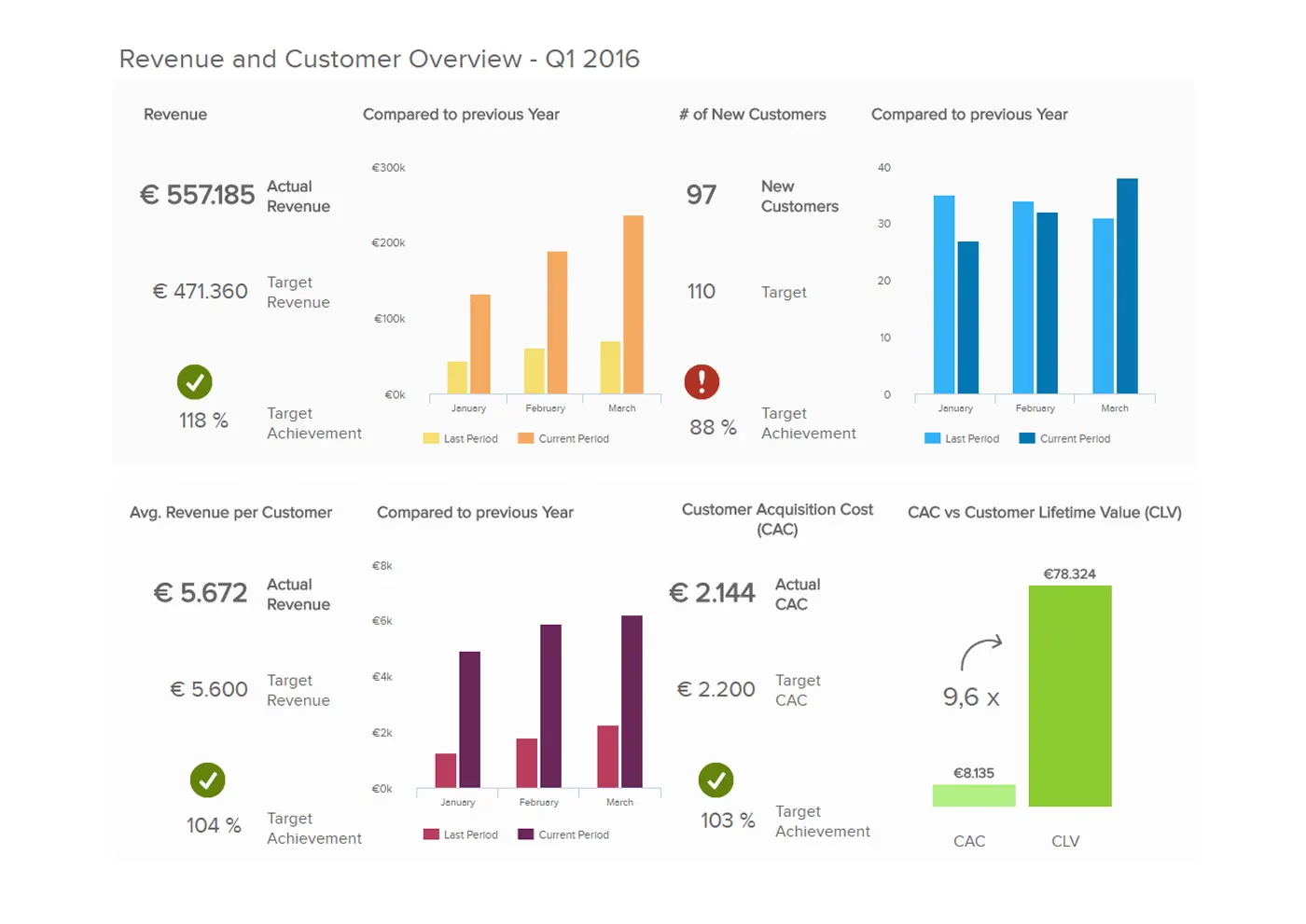
Have you heard of Datapine? They have been shaking up the world of data analytics through their impressive technological innovation. It's not just any run-of-the-mill KPI software platform. This gem offers an all-in-one solution for exploring, visualizing, and sharing data with super-sleek dashboards.
And get this - you don't need to be a tech wiz to use Datapine. Their modern self-service analytics functions and intuitive user interface make it easy for anyone to access professional KPI analytics.
Datapine features include:
- Agile Analytics
- Insights
- Dashboards
- Reports
- Data Alerts
- Templates
Downsides
Limited flexibility with custom metrics and a higher price point for single users, impacting accessibility.
Pricing Plan
Starts at $219 per month, one user.
#7 Perdoo
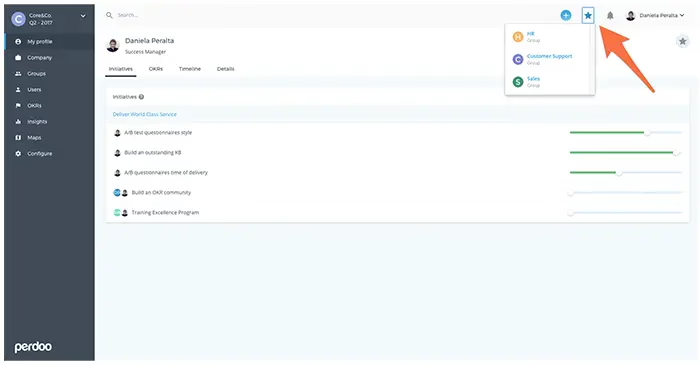
Perdoo is a cutting-edge KPI software platform. This solution streamlines strategy, goal, and people management, making it the ultimate tool for business success. Perdoo uses an innovative Objectives and Key Results (OKR) framework to implement and execute your company's strategy quickly.
Perdoo has helped countless organizations reach their full potential with a user-friendly interface and comprehensive features. Plus, with increased semantic richness and more detailed information, you can be confident that you're getting the best tool for your business needs.
Perdoo features include:
- OKR and KPI Management
- Dashboards
- Goal Settings and Tracking
- Team Management and Collaboration
Downsides
Geared toward OKR tracking, which may not suit all businesses; its free plan has limited features and users.
Pricing Plan
$7.50 - $19.50 per user after that. Up to 10 users and limited features free.
#8 Hive
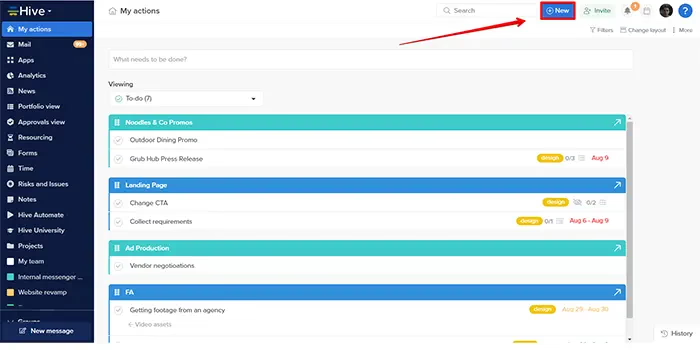
If you're in search of a comprehensive data visualization and KPI software tool, look no further than Hive. This latest product version offers a range of features that make it a top choice for businesses of all sizes.
One of the features of Hive is its Goals dashboard. This dashboard gives users an overview of their organization's performance in various areas and lets them drill down into specific metrics to see where they need to improve.
Another critical feature of Hive is its ability to handle large datasets. Built on top of Hadoop, Hive is designed to work efficiently with massive amounts of data, allowing you to manage and analyze your KPIs more effectively. And with various data visualization tools, including Tableau, HUE Beeswax, HBase Pig, and Zeppelin, you can get a clear picture of your data and uncover insights that may have otherwise gone unnoticed.
Hive features include:
- Goals
- Time Tracking
- Collaboration
- Analytics
- Dashboards
- AI Assist
Downsides
Primarily built for project management; lacks the full analytical depth some KPI-specific tools offer.
Pricing Plan
$18 per user per month, or limited features free for ten users.
#9 Geckoboard
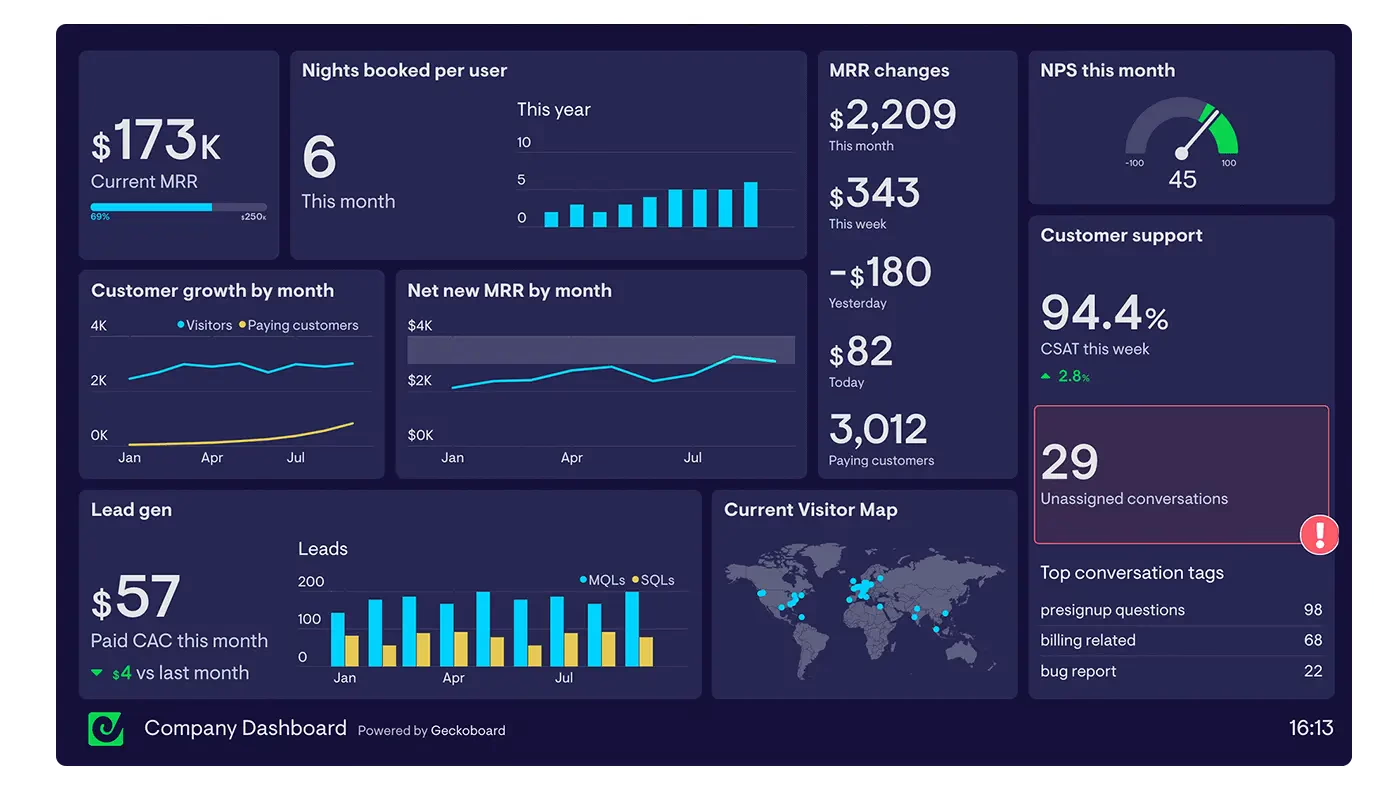
Geckoboard is a revolutionary KPI software tool that enables businesses to monitor their metrics on a real-time basis. This tool is designed to help enterprises to keep track of their performance against set targets, make informed decisions, and eventually achieve their goals. Geckoboard has become synonymous with simplicity, increased visibility, and actionable insights.
From a user perspective, Geckoboard integrates with more than 60 different channels, including Google Analytics, Salesforce, Zendesk, and Slack, making it one of the most versatile KPI software tools on the market. The tool provides a range of different data visualizations, including line graphs, bar charts, and funnel visuals, all of which can be customized to fit a specific organization's style and needs.
Geckoboard features include:
- KPI Dashboard
- Data Integrations
- Dashboard Examples
- TV Ready
Downsides
Focuses on dashboard visuals, with fewer in-depth analytics options, making it ideal for simpler KPI displays only.
Pricing Plan
$49 per month for 3 users - $699 per month for 25 users
#10 Databox
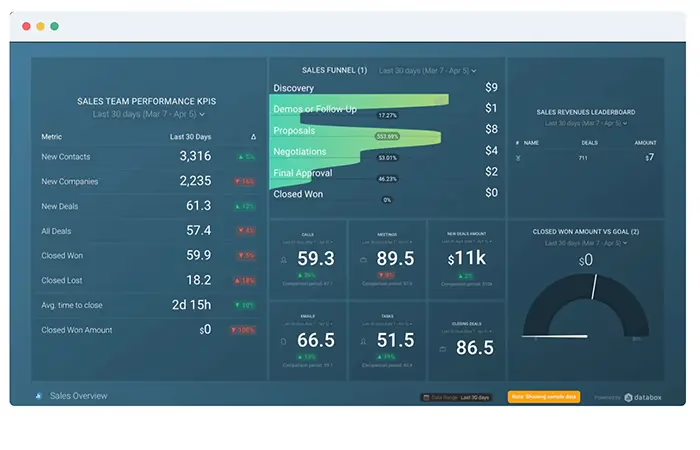
With Databox, you can easily set up custom dashboards and reports that give you a real-time view of your website traffic, engagement rates, and conversion metrics. Whether you are a small business owner looking to optimize your online presence or a marketing team leader tasked with improving ROI, Databox makes it easy to monitor your performance, spot trends, and make data-driven decisions.
One of the benefits of Databox is its flexibility and ease of use. Whether you are a beginner or an experienced marketer, you'll find the platform intuitive and user-friendly. Plus, with a wide range of integrations available (including tools like Google Analytics, HubSpot, and Facebook Ads), you can pull data from all your favorite sources and get a holistic view of your digital performance.
Databox features include:
- Reports
- Dashboards
- Scorecards
- Custom Metric Builder
Downsides
Limited customization options and may not suit companies needing granular data analysis capabilities.
Pricing Plan
$91 per month for 5 users - $289 per month for unlimited users.
#11 Plecto
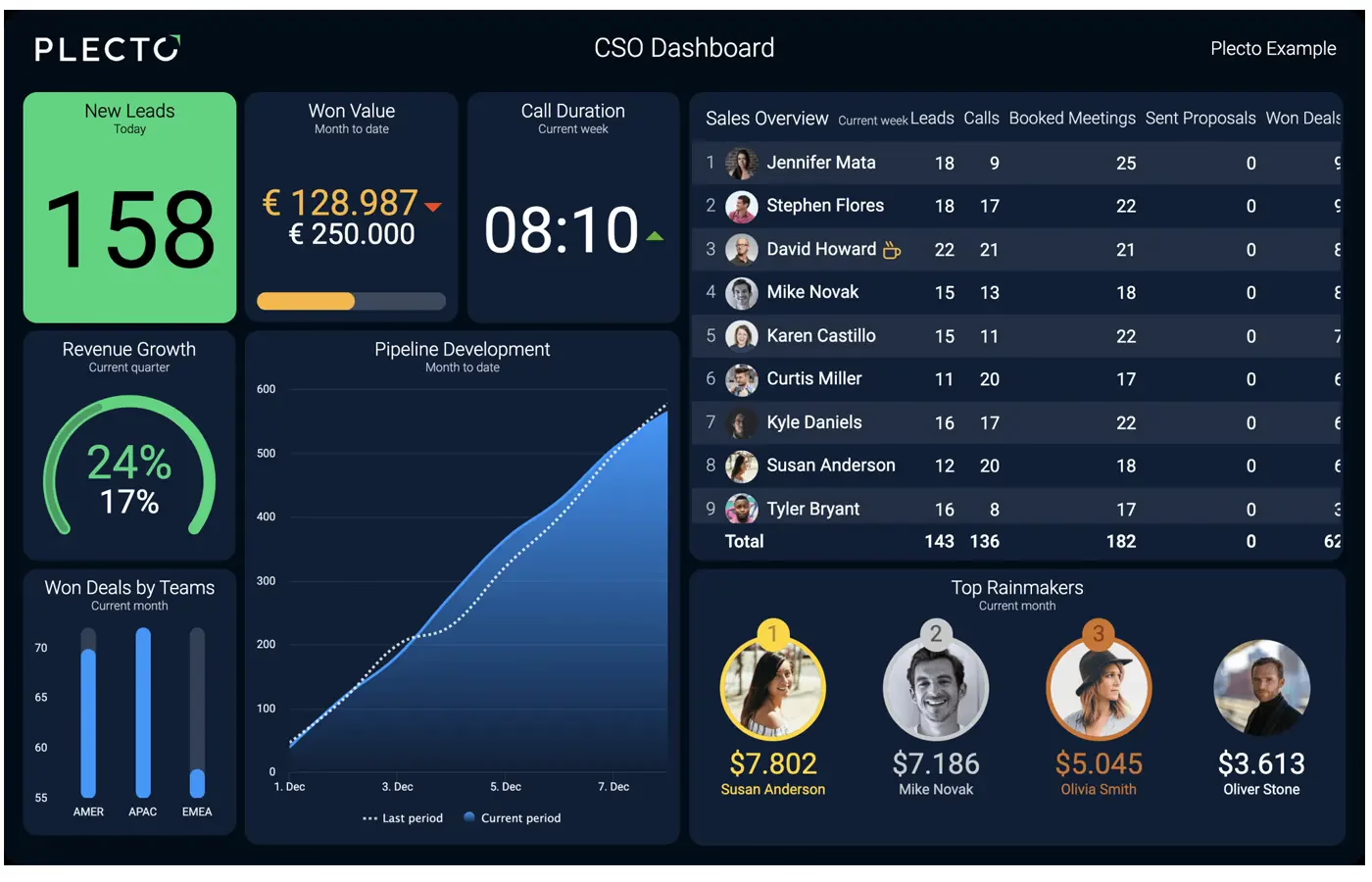
Are you looking for a powerful and fun solution to help your team stay motivated and productive? Look no further than Plecto! This innovative platform is designed to provide real-time data insights and engaging visualizations that help your team stay on top of their goals and perform at their best.
With Plecto, you can easily track your team's progress and KPIs in an informative and engaging way. Whether you're visualizing your sales numbers, tracking your support tickets, or keeping tabs on employee performance, Plecto is the perfect tool for the job.
And with real-time data updates and mobile access, you can stay on top of your team's progress no matter where you are.
Plecto features include:
- KPI Coaching Tools
- Gamification
- Dashboards
- Custom Reports
Downsides
Pricey compared to competitors; focuses on gamification, which may not appeal to all users.
Pricing Plan
$220 per month for 10 licenses or $375 per month inc Reports and SQL Integrations.
#12 Qlik Sense
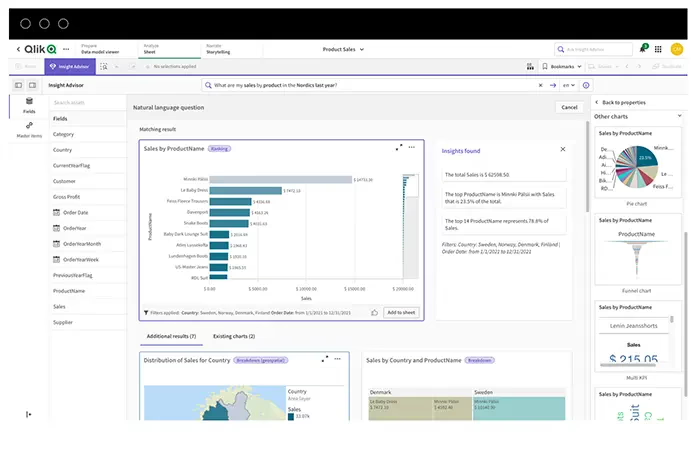
Introducing the Key Performance Indicators (KPI) capabilities of Qlik Sense. This business intelligence tool utilizes data-driven insights to monitor your organization's performance. You can easily track and measure your KPI goals and objectives through the platform's advanced data visualization and dashboards, enabling quick decision-making and driving optimal business outcomes.
Qlik Sense empowers you to gain a deeper understanding of your organization's performance, enabling you to identify trends, uncover hidden insights, and monitor the overall health of your business. With Qlik Sense's KPI capabilities, you can enhance your business strategy and accelerate growth by ensuring your initiatives align with your goals.
Qlik Sense features include:
- Self-service Visualization
- Interactive Dashboards
- Reporting
- Alerting and Actions
- Custom Embedding
Downsides
Requires training for effective use, with a more complicated interface compared to beginner-friendly options.
Pricing Plan
$30 per user per month.
#13 Cascade
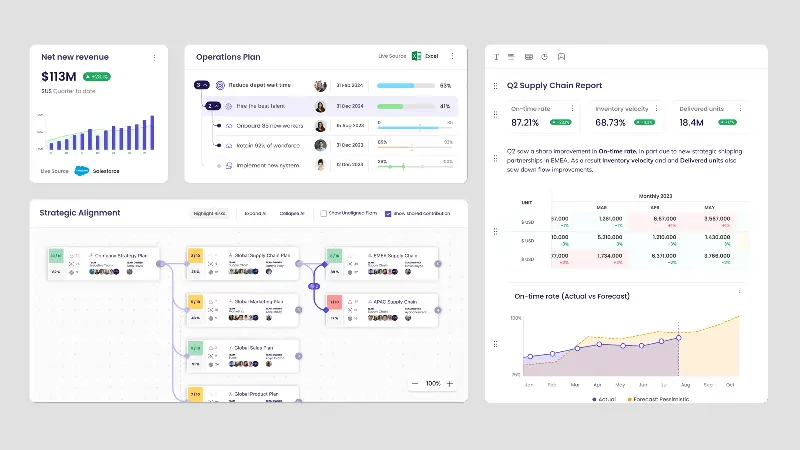
Cascade is a KPI dashboard software that helps businesses track their progress toward achieving their company goals. It offers a unified approach to KPI tracking, reporting, and planning.
Cascade's features include:
-
Track KPIs:
Cascade allows you to track your Key Performance Indicators (KPIs) in sync with your business goals. You can measure and monitor specific metrics businesses use to evaluate their progress toward achieving their organizations' goals.
-
Collaborate:
Cascade allows teams to collaborate on projects without the endless email threads and check-ins. You can align with many strategies and execute more of the right work faster.
-
Save time:
Cascade saves 20+ hours per month through instant communication.
Downsides
Designed primarily for strategic planning, which may limit appeal for companies focused purely on KPI tracking.
Pricing Plan
You will need to discuss your requirements with Cascade's sales team to obtain pricing information.
#14 KPI Fire
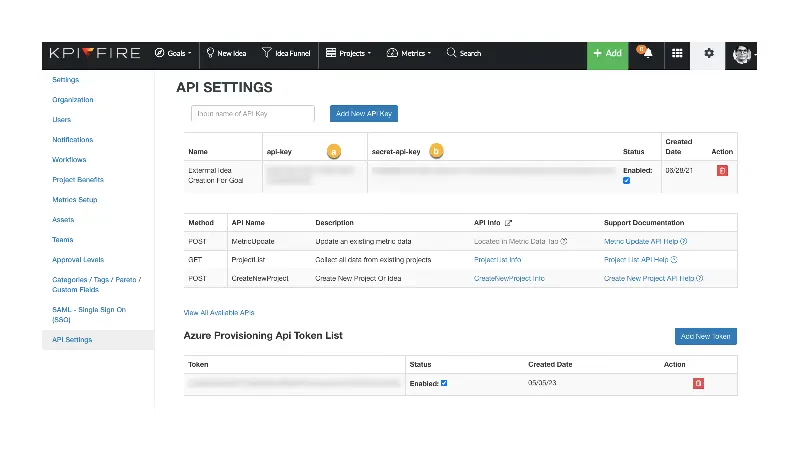
KPI Fire's strategy execution KPI software helps businesses achieve their strategic goals by aligning their improvement projects with their KPIs. This software provides a unified KPI tracking, reporting, and planning approach. With KPI Fire, you can track your Key Performance Indicators (KPIs) in sync with your business goals, measure and monitor specific metrics that businesses use to evaluate their progress toward achieving their company goals and quantify the performance of your business improvement program.
KPI Fire's features include:
-
Collaboration:
KPI Fire helps teams collaborate on cross-functional projects without the endless email threads and check-ins. You can align with one or many strategies and execute more of the right work, faster 123.
-
Centralized observability:
KPI Fire links metrics, initiatives, and outcomes, providing context to interpret your KPIs effectively.
-
Quantify performance:
KPI Fire helps you quantify the performance of your business improvement program. Lean, Six Sigma, Balanced Scorecard, and Continuous Improvement are all supported.
-
Project and Portfolio Management:
KPI Fire provides a single source of information for your continuous improvement program idea funnel and projects. It also includes special tools for tracking project impact and financial benefit.
Downsides
Lacks some integrations, especially for larger organizations, and its pricing is not transparent without a demo.
Pricing Plan
You will need to discuss your requirements with KPI Fire's demo team to obtain pricing information.
At a Glance, KPI Software platforms compared
| Provider | Price / User per Month | Free Trial | Key Features |
|---|---|---|---|
| SimpleKPI | Up to 5 users: $49, Unlimited users $129 | 14 Day Free trial |
|
| Tableau | $70 - $15 per user per month | 14 Day Trial |
|
| Yellowfin | Starting from $50 per user per month | No |
|
| Klipfolio | $299 a month / 8 Users – Free for limited use | 14 Day Trial |
|
| Good Data | Starts at $1,000 per month, + additional workspace feed | 30 Day Trial |
|
| Datapine | $219 per month, 1 user | 14 Day Trial |
|
| Perdoo | Up to 10 users and limited features free. $7.50 - $19.50 per user after that. | No |
|
| Hive | $18 per user per month or limited features free for 10 users. | 14 Day Trial |
|
| Geckoboard | $49 per month for 3 users - $699 per month 25 users | 14 Day Trial |
|
| Databox | $91 per month 5 users - $289 per month unlimited users | 14 Day Trial |
|
| Plecto | $220 per month 10 licenses / $375 per month | 14 Day Trial |
|
| Qlik Sense | $30 per user per month | 30 Day Trial |
|
| Cascade | Contact for pricing | 14 Day Trial |
|
| KPI Fire | Contact for pricing | Demo |
|
What are the key KPI Software features you should consider?
When it comes to selecting KPI software, companies are often presented with an overwhelming number of choices. However, for most businesses, only five critical features must be considered.
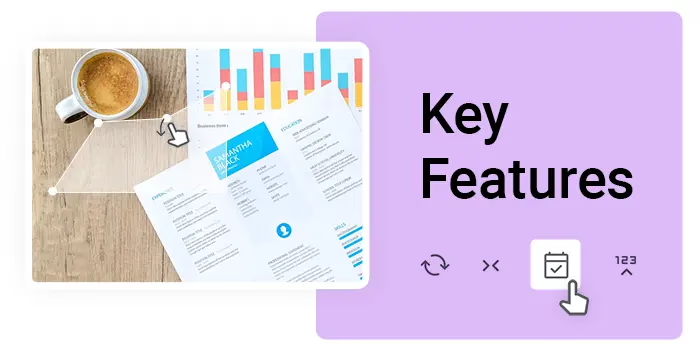
-
KPI Dashboards
First up: KPI dashboards. These dashboards provide a real-time snapshot of all the relevant KPIs in a single view, making it easy to identify trends and issues quickly. Plus, they're customizable based on a user's specific needs and preferences. Imagine being able to make informed business decisions at a glance instead of scouring through reams of data.
-
KPI Reports
Next, KPI reports provide in-depth analysis and insights. With KPI reports, users can drill down into the data to uncover patterns and trends that may be hidden in the raw data. These reports also make it easy to share key insights with stakeholders, such as investors or senior leadership. And much like dashboards, these reports are customizable and can be generated in various formats to meet the needs of different audiences.
-
Sharing and Collaboration
Speaking of sharing, the ability to share KPI dashboards is another critical feature. Collaboration is essential in today's work environment, and sharing dashboards and reports with multiple stakeholders makes it easier for teams to stay on the same page. Whether it's with team members, vendors, or customers, being able to share KPI data in a secure, user-friendly way is essential for effective collaboration.
-
Data Integrations
But what about data integrations? Connecting KPI software with existing systems can help businesses create a more streamlined and efficient workflow. For example, data from CRM systems, marketing automation tools, and accounting software can be integrated with KPI software to provide a comprehensive view of a company's performance. This feature can save valuable time by automating data collection and analysis.
-
Ease of use
Lastly, ease of use is critical when choosing KPI software. After all, what good is a bunch of fancy features if no one can figure out how to use them? That's why businesses should look for software that is intuitive and user-friendly. The best KPI software should be easy to navigate, with clear instructions and a welcoming interface.
How do I choose the right KPI software for me?
Choosing the perfect KPI software can be daunting, especially with the many available options. However, by carefully assessing crucial factors such as user-friendliness, data representation, analytical prowess, flexibility, and customization options, businesses can zero in on the ideal software platform that caters to their distinct needs.
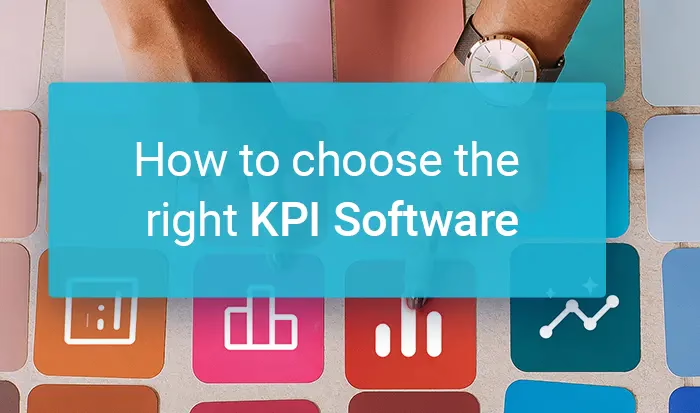
To tackle this quest, it's important to consider how easily users can navigate the software without the need for extensive training. Additionally, it's crucial for the software to efficiently represent data in a visual manner that's easy to understand.
The ability to analyze KPI data in-depth is another critical factor to look out for, along with the software's ability to scale to accommodate organizational needs and changes. Lastly, a customizable software platform allows businesses to tailor it to their requirements.
With a thorough analysis of these factors, businesses can confidently choose a KPI software platform that aligns with their needs, making data management and analysis a breeze.
Why do Companies use KPI Software?
In today's dynamic business landscape, companies must keep a close eye on their performance to achieve their strategic objectives and stay ahead of the competition. To this end, KPI software comes in handy as it provides objective feedback on business performance, helping businesses identify problems and make timely adjustments to their strategies.
What is the recommended KPI software for SMEs?
It can be challenging for businesses across all scales to keep track of their key performance indicators (KPIs). However, some large market players tend to levy a per-user fee for KPI tracking, which can cause implementation expenses to snowball. SimpleKPI emerges as a breath of fresh air in this scenario, offering unlimited users at an affordable, fixed price. By adopting SimpleKPI, businesses can breathe easily without worrying about any hidden fees or costs from additional users. This makes for a cost-effective and hassle-free KPI tracking methodology that any business can benefit from, regardless of its size or scale.
SimpleKPI offers an unlimited plan, so there are no hidden costs, and once more, it's also super easy to get started.
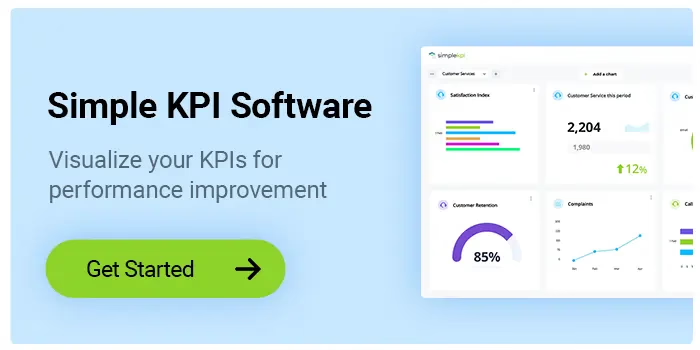
Conclusion
As we have discussed, various factors should be considered when selecting a platform that suits your needs and budget. The article has highlighted the most relevant features of the 14 best KPI software tools available.
It's essential to track your key performance indicators regularly to keep your business on track and aligned with your goals. With the help of KPI software, businesses of all sizes can now have access to affordable and practical tools that offer real-time data to optimize their management processes.
We encourage our readers to take a closer look at the 14 best KPI software platforms mentioned in this article and choose the one that matches their business requirements. By implementing the right KPI software, businesses can set their targets and track their performance regularly, which will help them make informed decisions, increase productivity, and reduce overhead costs.
KPI software is a tool that helps organizations track and measure performance against specific goals and objectives. It provides a platform for tracking and analyzing performance metrics, such as customer satisfaction, sales, production efficiency, and financial performance.
Set clear goals with timelines to choose meaningful KPIs—for example, a 10% profit increase in two years or 500 new leads in six months. Each goal might involve KPIs like tracking conversion rates to improve sales.
To ensure accuracy, teams must record relevant data consistently. While sales teams may already use metrics, HR might adopt new tools, such as satisfaction surveys. For larger goals, a project team can track progress and adjust quarterly. KPI software simplifies this by integrating data and visualizing trends over time.
Some suggest that KPIs are being replaced by agile metrics like OKRs, which focus on short-term adaptability. However, KPIs are still crucial for tracking consistent progress toward long-term goals and aligning teams with overall business objectives. Rather than outdated, KPIs are evolving, incorporating real-time data to stay relevant in today’s fast-paced business world.

by Stuart Kinsey
Stuart Kinsey writes on Key Performance Indicators, Dashboards, Marketing, and Business Strategy. He is a co-founder of SimpleKPI and has worked in creative and analytical services for over 25 years. He believes embracing KPIs and visualizing performance is essential for any organization to thrive and grow.
